Themed collection Journal of Materials Chemistry C Emerging Investigators

Contributors to the Emerging Investigators 2022 issue
Journal of Materials Chemistry C profiles contributors to the Emerging Investigators issue.
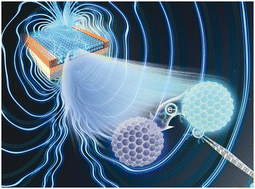
J. Mater. Chem. C, 2022,10, 13290-13302
https://doi.org/10.1039/D2TC90175G
Tissue-like organic electrochemical transistors
Organic electrochemical transistors (OECTs) are the perfect link between biology and microelectronics. This highlight backtracks the development of tissue-like OECTs (stretchable and healable) for applications at soft bioelectronic interfaces.
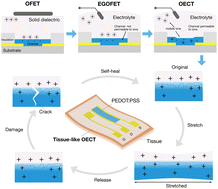
J. Mater. Chem. C, 2022,10, 13303-13311
https://doi.org/10.1039/D2TC01530G
Ferroelectricity in organic materials: from materials characteristics to de novo design
The development of new organic ferroelectrics has encountered some challenges and opportunities. In this perspective, we have summarised synthetic and computational design principles for high-performance organic ferroelectrics.
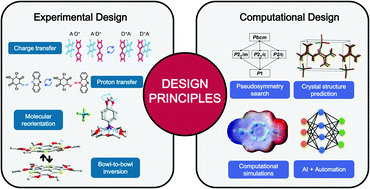
J. Mater. Chem. C, 2022,10, 13676-13689
https://doi.org/10.1039/D2TC01330D
Beyond electrical conductance: progress and prospects in single-molecule junctions
This perspective focuses on the new capabilities of single-molecule junctions beyond electrical conductance measurements and how they have enabled the investigation of crucial physical and chemical processes at the atomic and molecular scale.

J. Mater. Chem. C, 2022,10, 13717-13733
https://doi.org/10.1039/D2TC01155G
Toward real-world applications: promoting fast and efficient photoswitching in the solid state
This perspective focuses on the key challenges blocking the development of photoresponsive materials, and shows a guidance value for systematically designing solid-state photoresponsive materials.
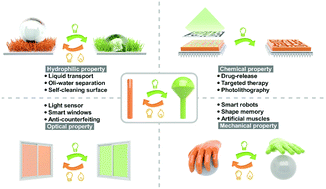
J. Mater. Chem. C, 2022,10, 13700-13716
https://doi.org/10.1039/D2TC01345B
Octahedral tilting in Prussian blue analogues
The trends in octahedral tilting in Prussian blue analogues are reviewed as a function of various structural factors. The link between tilting and functionality is discussed.
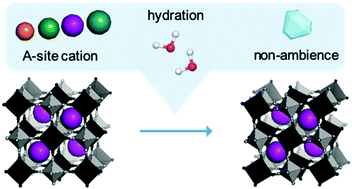
J. Mater. Chem. C, 2022,10, 13690-13699
https://doi.org/10.1039/D2TC00848C
Transistors and logic circuits enabled by 2D transition metal dichalcogenides: a state-of-the-art survey
The promising roadmap for boosting the performance of TMD FETs, circuitry applications, perspective of the computing scheme and challenges of current integration technologies have been reviewed.
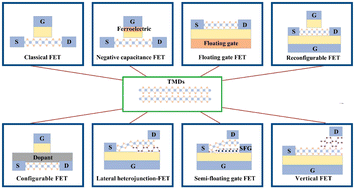
J. Mater. Chem. C, 2022,10, 17002-17026
https://doi.org/10.1039/D2TC00964A
Diamond surface engineering for molecular sensing with nitrogen—vacancy centers
Quantum sensing with shallow nitrogen-vacancy (NV) centers in diamond offer promise for chemical analysis. Preserving favorable NV spin and charge properties while enabling molecular surface functionalization remains a critical challenge.

J. Mater. Chem. C, 2022,10, 13533-13569
https://doi.org/10.1039/D2TC01258H
Recent advances in the interfacial engineering of organic–inorganic hybrid perovskite solar cells: a materials perspective
Interfacial engineering of perovskite solar cells and its key roles are highlighted, and an overview of the recent advances in their related strategies using different materials in improving the photovoltaic performance and stability is given.
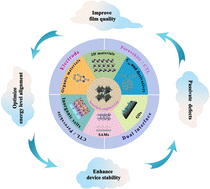
J. Mater. Chem. C, 2022,10, 13611-13645
https://doi.org/10.1039/D2TC01692C
Real-time views of morphological evolution in solution-processed organic photovoltaics
This review focuses on the morphological evolution of films for organic photovoltaics from the perspective of in situ measurements, showing factors governing the final morphology during liquid–solid transitions.
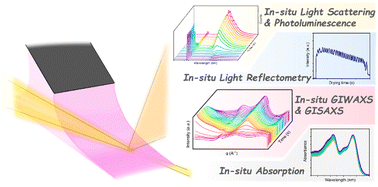
J. Mater. Chem. C, 2022,10, 13646-13675
https://doi.org/10.1039/D2TC02185D
Understanding and minimizing non-radiative recombination losses in perovskite light-emitting diodes
This review analyses predominant pathways of non-radiative recombination losses in perovskite light-emitting diodes, followed by a summary of recent advances in reducing such losses as well as future directions toward the radiative limit.

J. Mater. Chem. C, 2022,10, 13590-13610
https://doi.org/10.1039/D2TC01869A
Colloidal FAPbBr3 perovskite nanocrystals for light emission: what's going on?
This review summarizes the current prospect of FAPbBr3 nanocrystals – from synthesis to applications in light emitting diodes and highlights the challenges and promising strategies to mitigate the concerns.
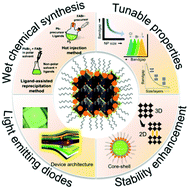
J. Mater. Chem. C, 2022,10, 13437-13461
https://doi.org/10.1039/D2TC01373H
Conducting polymers with redox active pendant groups: their application progress as organic electrode materials for rechargeable batteries
This review summarizes the application progress of conducting redox polymers with energy storage capability for different types of rechargeable batteries.

J. Mater. Chem. C, 2022,10, 13570-13589
https://doi.org/10.1039/D2TC01150F
Control of molecular conductance by pH
pH is emerging as a powerful control of electron transport through molecular junctions due to its direct manipulation of chemical structures and frontier orbitals of the molecules.
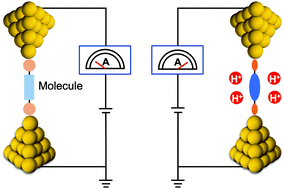
J. Mater. Chem. C, 2022,10, 13483-13498
https://doi.org/10.1039/D2TC01140A
A brief review on device operations and working mechanisms of organic transistor photomemories
Transistor photomemories have been vastly progressing along with their potential applications utilized in IoT and AI fields. Hence, it is essential to classify the device working principles with device operations to ease further development.

J. Mater. Chem. C, 2022,10, 13462-13482
https://doi.org/10.1039/D2TC01271E
Emerging polymer electrets for transistor-structured memory devices and artificial synapses
This review was aimed to analyze existing polymer-based technologies for electrets used in memory devices and artificial synapses. We categorize five types of electrets and analyze their performance, characteristics, applicability, and limitations.
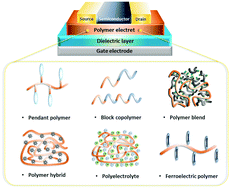
J. Mater. Chem. C, 2022,10, 13372-13394
https://doi.org/10.1039/D2TC01132H
Multiple-boron–nitrogen (multi-BN) doped π-conjugated systems for optoelectronics
This review covers recent advances in multiple boron–nitrogen doped π-conjugated systems including their synthetic strategies and applications in optoelectronic devices.
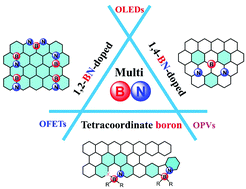
J. Mater. Chem. C, 2022,10, 13499-13532
https://doi.org/10.1039/D2TC01106A
Recent progress on the effects of impurities and defects on the properties of Ga2O3
Herein, the effects of impurities (e.g., donors, acceptors, co-doping impurities, Al and In, and surface passivators) and defects (e.g., intrinsic defects and deep-level defects) on the material properties of Ga2O3 are summarized.
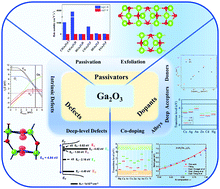
J. Mater. Chem. C, 2022,10, 13395-13436
https://doi.org/10.1039/D2TC01128J
Transparent stretchable hydrogel sensors: materials, design and applications
Illustration of strain-, pressure-, temperature-, humidity- and gas sensor.
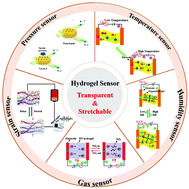
J. Mater. Chem. C, 2022,10, 13351-13371
https://doi.org/10.1039/D2TC01104B
Recent advances in the controlled chemical vapor deposition growth of bilayer 2D single crystals
Recent advances in the controllable growth of bilayer 2D single crystals via the chemical vapor deposition method are comprehensively presented.
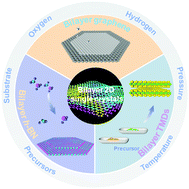
J. Mater. Chem. C, 2022,10, 13324-13350
https://doi.org/10.1039/D2TC01095J
Recent progress in polymer-based infrared photodetectors
This review summarizes the development and applications of polymer-based organic photodiodes and organic phototransistors, and provides an outlook on their development prospects and obstacles, aiming to propose new design strategies.
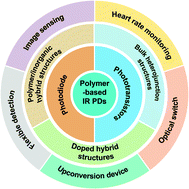
J. Mater. Chem. C, 2022,10, 13312-13323
https://doi.org/10.1039/D2TC00646D
Multi-material 3D printing-enabled multilayers for smart actuation via magnetic and thermal stimuli
Transitional compositions or phase-changing structures in specific layers can respond to environmental changes differently and show intelligent behaviors.
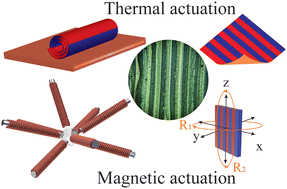
J. Mater. Chem. C, 2022,10, 13762-13770
https://doi.org/10.1039/D2TC01109C
2D semiconductor SnP2S6 as a new dielectric material for 2D electronics
2D metal thiophosphate SnP2S6 was discovered as a new dielectric layer with a high dielectric constant (≈23), realizing a low subthreshold slope down to 69.4 mV dec−1 in the field effect transistor device geometry.

J. Mater. Chem. C, 2022,10, 13753-13761
https://doi.org/10.1039/D2TC01340A
High-quality diamond microparticles containing SiV centers grown by chemical vapor deposition with preselected seeds
Diamond microparticles containing SiV centers with superior properties are fabricated on a Si substrate by CVD using salt-assisted air-oxidized nanodiamond seeds. Ultrasensitive all-optical thermometry is demonstrated by the high-quality sample.

J. Mater. Chem. C, 2022,10, 13734-13740
https://doi.org/10.1039/D2TC01090A
The influence of π–π stacking on the room temperature phosphorescence of phenothiazine 5,5-dioxide derivatives
Five phenothiazine 5,5-dioxide derivatives were designed to reveal their different RTP properties and inherent mechanism. The results show that the large π–π overlap within molecular dimer is beneficial for persistent RTP effect.
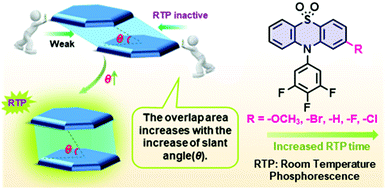
J. Mater. Chem. C, 2022,10, 13741-13746
https://doi.org/10.1039/D2TC01537D
Modulating the triplet chromophore environment to prolong the emission lifetime of ultralong organic phosphorescence
We demonstrate that changes in the surrounding environment of the triplet chromophore play a crucial role in changing the organic room-temperature phosphorescence lifetime, with a range from 0.84 ms (ET) to 325.26 ms (MT).
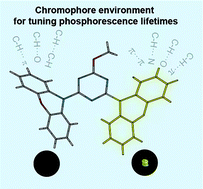
J. Mater. Chem. C, 2022,10, 13747-13752
https://doi.org/10.1039/D2TC00836J
Synthesis and electronic properties of bridged [8]-, [12]- and [16]-cyclo-para-phenylenes
Hoop-shaped π-conjugated macrocycles constitute a new family of π-conjugated systems displaying unique properties induced by their radially directed π-orbitals.
![Graphical abstract: Synthesis and electronic properties of bridged [8]-, [12]- and [16]-cyclo-para-phenylenes](/en/Image/Get?imageInfo.ImageType=GA&imageInfo.ImageIdentifier.ManuscriptID=D2TC00881E&imageInfo.ImageIdentifier.Year=2022)
J. Mater. Chem. C, 2022,10, 14000-14009
https://doi.org/10.1039/D2TC00881E
From molecules in solution to molecules on surfaces – using supramolecular dyads to form functional self-assembled networks on graphene
The formation of supramolecular dyads that can form ordered, 2D-assemblies on graphene is an intricate process. Using different molecular components allows us to control the positioning of the emissive unit in relation to the graphene substrate.

J. Mater. Chem. C, 2022,10, 13981-13988
https://doi.org/10.1039/D2TC01331B
Simultaneous reinforcement of the electrical and mechanical properties of carbon nanotube fibers by using a natural cross-linkable thermosetting polymer
Urushiol is infiltrated into carbon nanotube (CNT) fibers, and the urushiol infiltrated CNT (U-CNT) fibers are cross-linked by thermal or photochemical treatment. The cross-linked U-CNT (CL-U-CNT) fibers exhibit considerably enhanced properties.

J. Mater. Chem. C, 2022,10, 13974-13980
https://doi.org/10.1039/D2TC01139E
Donor–acceptor organogels and xerogels from C3-symmetric pyrene and naphthalene-diimide components
Association of C3-symmetric pyrene- and naphthalene diimide-based derivatives afforded gels through aromatic interactions. The corresponding (xero)gels displayed original spectroscopic features in comparison to the corresponding one-component materials.

J. Mater. Chem. C, 2022,10, 13989-13999
https://doi.org/10.1039/D2TC01799G
Role of structural dimensionality in the magneto-chiral dichroism of chiral molecular ferrimagnets
The optical and magneto-chiral optical properties of a 3D chiral molecular ferrimagnet based on CrIII and MnII building blocks have been investigated to unveil the role of structural dimensionality on magneto-chiral dichroism.
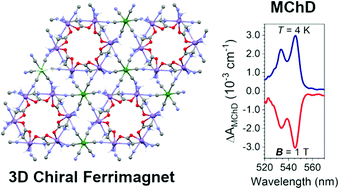
J. Mater. Chem. C, 2022,10, 13939-13945
https://doi.org/10.1039/D2TC01777F
A zero-field single-molecule magnet with luminescence thermometry capabilities containing soft donors
An investigation into the impact of soft donors on the optomagnetic and thermal sensing properties of lanthanide-based luminescent single-molecule magnets.

J. Mater. Chem. C, 2022,10, 13946-13953
https://doi.org/10.1039/D2TC01661C
PEDOT:PSS hydrogel gate electrodes for OTFT sensors
PEDOT:PSS hydrogel is used as soft, conductive gate electrodes for low-voltage hygroscopic insulator field effect transistors (HIFETs). HIFETs are sensitive to aqueous solutions of KCl, NaCl and H2O2, introduced through the hydrogel gate electrode.
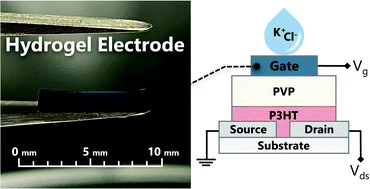
J. Mater. Chem. C, 2022,10, 13964-13973
https://doi.org/10.1039/D2TC01096H
Chiral nanostructures derived from europium(III) complexes for enhanced circularly polarised luminescence and antibacterial activity
Nanostructures formed from chiral Eu(III) complexes exhibit enhanced chiral luminescence and antibacterial activity.

J. Mater. Chem. C, 2022,10, 13954-13963
https://doi.org/10.1039/D2TC02193E
Pre- and post-assembly modifications of colloidal plasmonic arrays: the effect of size distribution, composition and annealing
Internal organization and composition of plasmonic colloidal array unit cells are engineered exploring both pre- and post- assembly modifications.
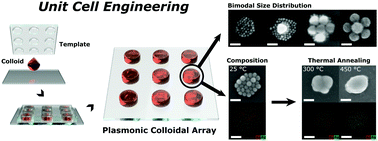
J. Mater. Chem. C, 2022,10, 13913-13921
https://doi.org/10.1039/D2TC01148D
Smart textiles for human–machine interface fabricated via a facile on-site vapor-phase polymerization
PEDOT deposition on 1D to 3D textiles is achieved by an on-site vapor polymerization and their application in human–machine interfaces is then explored.

J. Mater. Chem. C, 2022,10, 13930-13938
https://doi.org/10.1039/D2TC01618D
An ionic thermoelectric ratchet effect in polymeric electrolytes
By varying the solvent and concentration of PEG based electrolytes, we tuned the molar conductivity and revealed the correlation with the Seebeck coefficient, which follows the theory of the thermoelectric ratchet effect in ions with hopping dynamics.
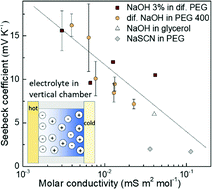
J. Mater. Chem. C, 2022,10, 13922-13929
https://doi.org/10.1039/D2TC01130A
n-Type conjugated polymers comprising bithiophene imide and multifluorinated thiophene moieties synthesized by direct arylation polycondensation
n-Type conjugated polymers were synthesized by environmentally benign direct arylation polycondensation. With these polymers, OTFTs with μe of up to 0.72 cm2 V−1 s−1 were fabricated.
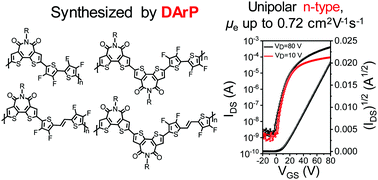
J. Mater. Chem. C, 2022,10, 13905-13912
https://doi.org/10.1039/D2TC00732K
Compositional influence of local and long-range polarity in the frustrated pyrochlore system Bi2−xRExTi2O7 (RE = Y3+,Ho3+)
Cation off-centering is crystallography frustrated in the pyrochlore but exhibits local ordering.
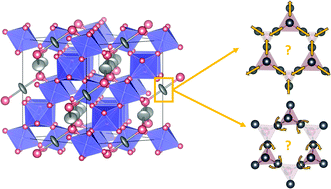
J. Mater. Chem. C, 2022,10, 13886-13895
https://doi.org/10.1039/D2TC01328B
Synergistic self-assembly of rod-like monomers in blue phase liquid crystals for tunable optical properties
The synergistic self-assembly behavior of the rod-like mesogenic monomers and the effects of their composition and concentration on the BP lattice are revealed during soft crystal growth and transformations, providing tunable photonic properties.
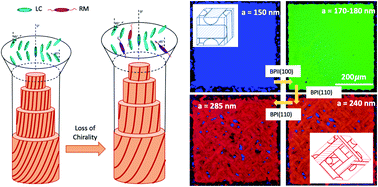
J. Mater. Chem. C, 2022,10, 13778-13788
https://doi.org/10.1039/D2TC01333A
Lithium-ion distribution and motion in two-dimensional covalent organic frameworks: the example of TAPB-PDA COF
Efficient molecular dynamics simulations with electronic continuum correction show that ion clusters form inside covalent organic frameworks, resulting in noncontinuous pathways detrimental to Li+ transport.

J. Mater. Chem. C, 2022,10, 13834-13843
https://doi.org/10.1039/D2TC01076C
Robust chain aggregation of low-entropy rigid ladder polymers in solution
Conjugated ladder polymer forms highly robust, temperature-insensitive aggregation in the solution due to low entropy change of rigid backbone, which is promising for highly robust intermolecular interaction at high temperature.

J. Mater. Chem. C, 2022,10, 13896-13904
https://doi.org/10.1039/D2TC00761D
Deep-blue emission and thermally activated delayed fluorescence via Dimroth rearrangement of tris(triazolo)triazines
Three luminescent donor–acceptor compounds were prepared based on the Dimroth rearrangement of tris(triazolo)triazines (TTT).
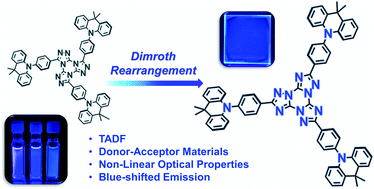
J. Mater. Chem. C, 2022,10, 13871-13877
https://doi.org/10.1039/D2TC01153K
Semitransparent near-infrared Sn–Pb hybrid perovskite photodetectors
We report semitransparent NIR perovskite photodetectors based on tin–lead hybrid perovskites, by using very thin film perovskite layers and transparent indium tin oxide electrodes.
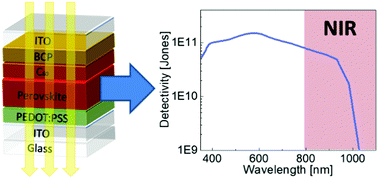
J. Mater. Chem. C, 2022,10, 13878-13885
https://doi.org/10.1039/D2TC01052F
Doping of semicrystalline conjugated polymers: dopants within alkyl chains do it better
Electronic structure calculations unveil structure-property relationships in doped polymers: dopants inserted in the alkyl chains are stronger electron acceptors than those in conjugated backbones, leading to integer charge transfer complexes.
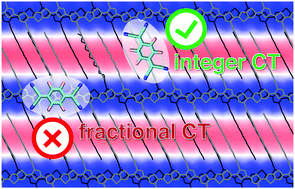
J. Mater. Chem. C, 2022,10, 13815-13825
https://doi.org/10.1039/D2TC01115H
Rationalization and tuning of doublet emission in organic radicals
The degree of mixing of intramolecular charge transfer excitations can be used to brighten the lowest doublet excited state of TTM.
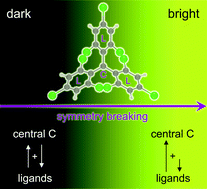
J. Mater. Chem. C, 2022,10, 13826-13833
https://doi.org/10.1039/D2TC01632J
How to calibrate luminescent crossover thermometers: a note on “quasi”-Boltzmann systems
Boltzmann or not? Most luminescent thermometers rely on a configurational crossover between two excited states with high mutual non-radiative transition rates and relative sensitivity. It is shown that these materials follow a “quasi”-Boltzmann law as is demonstrated for the case of Sm2+.
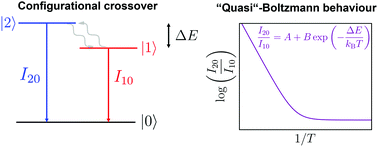
J. Mater. Chem. C, 2022,10, 13805-13814
https://doi.org/10.1039/D2TC01152B
Modulation of the intramolecular hydrogen bonding and push–pull electron effects toward realizing highly efficient organic room temperature phosphorescence
A facile design strategy based on the structural control of intramolecular hydrogen bonding and push–pull electron effects was proposed to construct highly efficient UORTP materials.
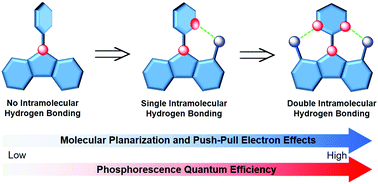
J. Mater. Chem. C, 2022,10, 13797-13804
https://doi.org/10.1039/D2TC01093C
Thermogalvanic hydrogels for self-powered temperature monitoring in extreme environments
A gel electrolyte-based thermogalvanic device with I−/I3− as a redox pair is fabricated, which shows a preferred temperature tolerance and superior anti-drying capacity. Thus, a gel-based temperature monitoring system was developed.
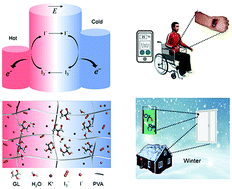
J. Mater. Chem. C, 2022,10, 13789-13796
https://doi.org/10.1039/D2TC00889K
Platinum(II) metallacycles as highly affinitive hosts for dendritic amino acids with tunable circularly polarized luminescence
A strategy to transfer chirality via host–guest interaction to shape-persistent metallacycles with potential chiroptical applications is established.
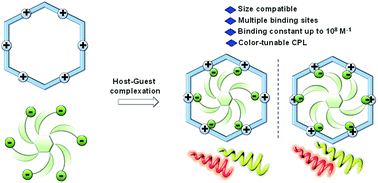
J. Mater. Chem. C, 2022,10, 13860-13870
https://doi.org/10.1039/D2TC00032F
Synergistically enhanced electrical transport properties of SrTiO3via Fermi level regulation and modulation doping
The thermoelectric performance of the insulator SrTiO3 was improved through synergistically enhanced electrical transport properties via Fermi level regulation and modulation doping.

J. Mater. Chem. C, 2022,10, 13851-13859
https://doi.org/10.1039/D2TC00719C
Three-dimensional all-inorganic dual halogen emitter Cs2Cd2BrCl5 exhibiting broadband white-light emission
Three-dimensional all-inorganic dual halogen emitter Cs2Cd2BrCl5 exhibits broadband white-light emission, which is originated from self-trapped excitons.
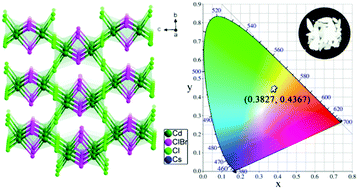
J. Mater. Chem. C, 2022,10, 13844-13850
https://doi.org/10.1039/D1TC06086D
Magnetoresistance of high mobility HgTe quantum dot films with controlled charging
The magnetoresistance of HgTe quantum dot films, exhibiting a well-defined 1Se state charging and a relatively high mobility (1–10 cm2 V−1 s−1), is measured with controlled occupation of the first electronic state.
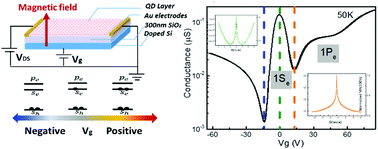
J. Mater. Chem. C, 2022,10, 13771-13777
https://doi.org/10.1039/D1TC05202K
About this collection
Journal of Materials Chemistry C is pleased to present this themed issue highlighting the rising stars of materials chemistry research in 2022. This issue showcases the very best work from materials chemists in the early stages of their independent career.
Each contributor was recommended by experts in their fields as carrying out work with the potential to influence future directions in materials chemistry with applications in optical, magnetic & electronic devices. Congratulations to all the outstanding researchers featured.
See also:
Journal of Materials Chemistry A Emerging Investigators
Journal of Materials Chemistry B Emerging Investigators